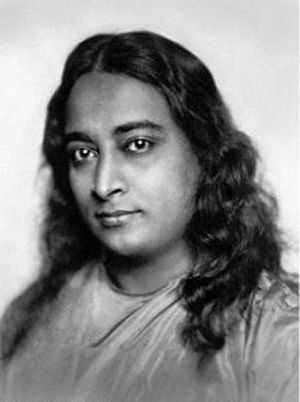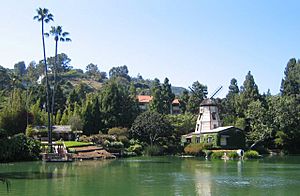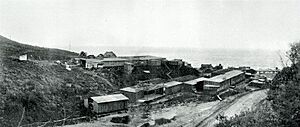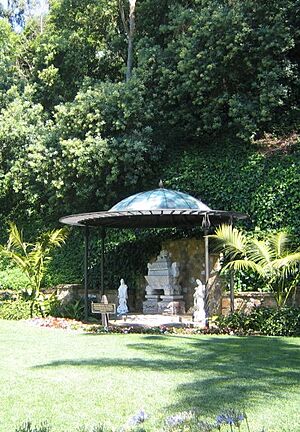Self-Realization Fellowship Lake Shrine facts for kids
Quick facts for kids Self-Realization Fellowship Lake Shrine |
|
|---|---|

Main Temple of the Lake Shrine
|
|
| Religion | |
| Affiliation | Self-Realization Fellowship |
| Status | Temple and Retreat Center |
| Location | |
| Location |
|
| Architecture | |
| Architectural style | Combination of Eastern and Western |
| Founder | Paramahansa Yogananda |
| Completed | 1996 |
| Specifications | |
| Capacity | 400 (sanctuary seating) |
| Height (max) | 58 feet (18 m) |
| Site area | 4,000 square feet (370 m2) |
| Materials | concrete, stained glass, wood, and ceramic tile |
| Website | |
| lakeshrine.org | |
The Self-Realization Fellowship Lake Shrine is a beautiful and peaceful place located near the Pacific Ocean in Pacific Palisades, California. It was started by Paramahansa Yogananda on August 20, 1950. The Lake Shrine is owned by the Self-Realization Fellowship.
This special place covers about 10-acre (40,000 m2) of land. It has lovely gardens, a big lake fed by natural springs, and hillsides all around. You can see many different plants and animals here, like swans, ducks, koi fish, turtles, and beautiful lotus flowers. The area is shaped like a natural outdoor theater. Thousands of people visit the Lake Shrine every year.
Contents
Exploring the Lake Shrine
When you visit the Lake Shrine, you can get information at the visitor center. The grounds are full of amazing sights. There are waterfalls, fountains, and colorful flower beds. White swans glide across the lake. You'll find pretty fern grottos and lily ponds. There's even a Dutch windmill that serves as a chapel.
The Court of Religions
The Lake Shrine has a special area called the Court of Religions. It honors five main religions of the world. You can see symbols for each one:
- A cross for Christianity
- A Star of David for Judaism
- A Wheel of Law for Buddhism
- A crescent moon and star for Islam
- The Om symbol for Hinduism
Paramahansa Yogananda believed that all faiths have a deep connection and unite us. Besides symbols, you'll also see statues of Krishna and other Hindu gods. There's a life-size statue of Jesus Christ above a waterfall, and statues of Francis of Assisi and the Madonna and Child.
Golden Lotus Archway and Gandhi Memorial
A tall, white archway with blue tiles and gold lotus flowers stands out. It's called the golden lotus archway. You can see it from everywhere on the grounds. This archway frames the Mahatma Gandhi World Peace Memorial. This outdoor shrine holds a part of Mahatma Gandhi's ashes. They are kept in a 1,000-year-old stone box from China.
Gardens and Other Features
The gardens have small brick paths and short stairways. These lead to quiet spots where you can meditate or just enjoy the view. There's a gift shop next to a museum. The museum focuses on Paramahansa Yogananda, the founder. The gift shop sells arts and crafts from India.
You can also find a Dutch windmill that was turned into a chapel. There's a houseboat on the lake, a bookstore, and a temple that looks out over the water.
History of the Lake Shrine
The land where the Lake Shrine now sits was once part of a much larger area. It was called Bison Ranch and covered about 460-acre (1.9 km2). In 1912, silent film producer Thomas H. Ince bought it to build his movie studio. It was known as Inceville.
Over the years, the studio changed hands and names several times. Fires often broke out, destroying many of the wooden buildings. By 1922, a big fire destroyed almost all the remaining structures, except for an old stone church.
After the fires, the property was used as a sand and gravel quarry. Later, a real estate leader named Alphonzo Bell Sr. bought it. In 1927, he tried to level the canyon for building. But the project was never finished. This left a large basin that filled with water from four natural springs. This 2.5-acre water body (10,000 m2) became known as Lake Santa Ynez. It is the only spring-fed lake in Los Angeles.
For over ten years, the property remained undeveloped. The lake became a local swimming spot. In 1940, H. Everett "Big Mac" McElroy bought the land. He saw the potential for a beautiful garden with trees, flowers, and paths. He and his wife lived in a houseboat on the lake. They also built a mill house, which is now the gift shop and museum. McElroy also built a replica of a 16th-century Dutch windmill, which later became the first chapel.
In 1948, the McElroys sold the property to Rene Williams and Joseph M. Gross. Mr. Gross had a dream three times about a platform in the middle of the lake where ministers from all religions spoke. This dream inspired him to contact the Self-Realization Fellowship.
When Mr. Gross called, Paramahansa Yogananda already knew why he was calling! Yogananda visited the site and immediately planned to create a shrine for all religions. With help from supporters, he bought the property in 1949. He then built the temple, meditation garden, and the Mahatma Gandhi peace memorial.
Yogananda oversaw the project himself, often staying in the houseboat. He wanted to create a peaceful and beautiful place that showed all aspects of God. The Lake Shrine officially opened on August 20, 1950. About 1,500 people attended the dedication. Within eight months, ten thousand people had visited.
Yogananda felt the location reminded him of Kashmir. He described the many plants and features, like Guadalupe palms, Chinese rice-paper trees, and fruit trees. He mentioned paths, bridges, and exotic flowers. He also noted the Dutch windmill house, which once had a cafe.
On March 6, 1952, the day before he passed away, Paramahansa Yogananda had a special gathering with monks. He chanted and played the organ.
Over the years, many improvements have been made. The main temple was built in 1996. The monks' living quarters were built in 1997. The Gandhi peace memorial got a new roof in 2002. The Court of Religions and the entrance gate were renovated in 2003. The houseboat was restored in 2007. The Windmill Chapel was restored in 2015, and a new landing was added in 2023.
In 2025, the Lake Shrine was surrounded by flames during the Palisades Fire. A family bravely defended the site for four days. Most of the facilities were saved, though there was some damage.
Special Features
Gandhi World Peace Memorial
The Lake Shrine is home to the Mahatma Gandhi World Peace Memorial. Paramahansa Yogananda designed it as a "wall-less temple." It honors Mahatma Gandhi, who led India to freedom using nonviolent methods.
Along the southern shore of the lake, you'll see the golden lotus archway. It has a large golden top with lotus flowers. The most important part of the memorial is a thousand-year-old stone box from China. Inside this box, a small part of Gandhi's ashes is kept in a special metal container. Two statues of Guanyin stand next to the stone box.
Gandhi's ashes were sent to Yogananda by a friend from India. This friend wrote that Yogananda was the only person outside India to receive Gandhi's ashes.
Some people find it unusual that Gandhi's ashes are kept here. Hindu tradition usually involves scattering ashes in water. There have been discussions about whether the ashes at the Lake Shrine should be put into water. However, Gandhi's family members do not want the shrines to be broken to remove the ashes.
Windmill Chapel
The previous owners, the McElroys, built a real-looking 16th-century Dutch windmill. Even though it was never used to grind grain, its sails can turn in the wind. Yogananda later turned this windmill into a chapel. Meditations and services were held here. Until the new temple was built in 1996, the windmill chapel was the main place for services at the Lake Shrine. It was made bigger twice to fit more people.
The chapel was closed in 2013 because of weather damage, termites, and the 1994 Northridge earthquake. Restoring it became a big project. Workers found that the windmill tower was not strongly connected to the lower part. This made it unsafe in earthquakes. So, the restoration became a major engineering task.
During the nearly two-year restoration, the building's look was carefully kept the same. Steel beams were added to make the tower strong against earthquakes. Rare, old redwood beams were used to build new windmill sails and other parts. This wood is very strong and can last for hundreds of years.
Other improvements included fixing the roofs, adding more hidden steel support, and perfectly remaking the windmill sails and windows. The tiles on the windmill tower were removed, numbered, and put back in the same order after repairs. The chapel reopened on July 27, 2015.
Lake, Waterfalls, and Animals
Lake Santa Ynez is about 15 feet (4.6 m) deep on average. It is fed by two waterfalls. One waterfall drops about 25 feet (7.6 m), and another series of waterfalls drops about 10 feet (3.0 m).
Paramahansa Yogananda, whose title means "supreme swan," encouraged swans to live on the Lake Shrine. You can see their large nests there. A minister once shared a story about three pairs of swans at the Lake Shrine: one white, one black, and one white with a black neck. Even though the lake was big enough, the swans fought. They had to be separated by dividing the lake into three sections. The minister said that swans are like people. If everyone wants everything for themselves, there will be conflict. But if people follow good rules and think about everyone's well-being, we can have peace.
See also
 In Spanish: Self-Realization Fellowship Lake Shrine para niños
In Spanish: Self-Realization Fellowship Lake Shrine para niños
- Encinitas Gardens of Self Realization Fellowship Hermitage















